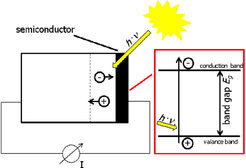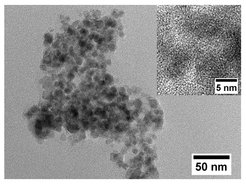Photocatalysis and Photovoltaics
Nowadays, environment pollution and energy crisis are widely concerned all over the world. It is an urgent task to develop environment-friendly technologies for alternative clean energies. Photocatalysis is one of the most promising methods for such subjects. Therefore, we focus on the development of novel photocatalysts based on nanostructured metal oxy-nitrides with high efficiency, aiming to make our contributions to a sustainable society.
Similarly Photovoltaics is important technologies for generating alternative energies. The principle of this technique is the conversion of solar energy to electrical energy with the help of solar cells persisting of semiconductor materials. The classical material of solar cells is crystalline silicon but other materials are feasible such as photosensitive polymer or nanosized semiconductors.

Figure 1: Principle of a solar cell
Promising materials are metal oxynitride nanoparticles like TaON or ZrON. The advantage of using metal oxynitride nanoparticles is the possibility of tailoring the size of the band gap Eg, simply by changing the nitrogen loading, indeed, the substitution of N with O in ZrO2 enabled the transition from insulator to semiconductor.
Synthesis of ZrON is performed by the Urea-glass-route and leads to nanoparticles with size of ca. 8 nm.

Figure 2: ZrON nanoparticles

